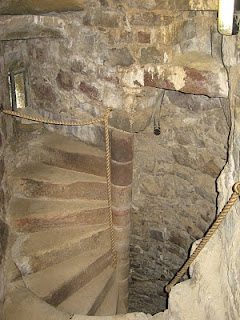Exploring Scotland 1 Castle at a Time Part 11 Drum Castle
Drum Castle was awarded to William de Irwin by Robert the Bruce in 1325. The Irvines were in possession of the castle for six hundred and fifty years until the last Laird of Drum, Henry Quinton Forbes Irvine bequeathed the castle and three hundred acres of land to the National Trust of Scotland upon his death in 1975.
Drum castle was probably one of the most interesting castles we visited. It was actually a castle with three time periods enclosed within one skin. One side of the castle was Jacobean with an addition along the backside of it that marked the Victorian Era and a large rectangular tower distictly Medieval. And what was so interesting you could tell which was which. The Jacobean part of the castle had narrow spiraled stone stairs and the Victorian part of the castle had wooden spiral stairs with bent wood railings.
This is the front of the Jacobean part of the castle.
With this image of this side of the castle you can get an understanding of how different each section truely is.
This is the very back of the Castle and the entrance into the Medieval courtyard. The Rectangular Tower is the greatest part of the original castle constructed in 1200 then added to in the 1300's. It was used by Robert the Bruce as a hunting lodge when he visited.
Inside the courtyard you can look at the back of the castle and see the Victorian addition that runs along the length of the entire keep.
Inside the castle on the first floor there are a series of rooms that follow the normal plan of a Jacobean Castle where you have to go through one room to get to the next. I loved the Jacobean fireplaces in the drawing room and the diningroom. Both those rooms had beautiful wooden ceilings.
The next floor up there's a galary that runs the length of the house and offers access to the bedrooms there.
The Jacobean parts of the house had four foot wide window ledges with wooden shutters mounted inside.
After we viewed the interior of the house we went outside to go into the 13th century tower.
The tower was a great contrast to the finished beauty of the rest of the castle. The dirt floors and rough hewn walls seemed stark and primitive in comparison.
The Structure has 12 foot thick walls in spots and narrow spiral stairs are a real challenge to navigate but once you get to the top it's wonderful to look out on the surrounding area. 

The Chapel was built in the 1500's and renovated in the 1800's. Weddings are still performed there today.
Tomorrow I'll post my photos of Crathes. I hope you found Drum Castle as interesting as I did.
Teresa R.















Comments
I'm so pleased that you're enjoying the posts.
Thank you for reading them.
Teresa R.
We didn't get to go to Dalhousie but I know that Dalhousie Castle was founded by the Ramsays, and they were of Norman-English descent. The drum tower of the current castle was built in the 1500's but it had to be on an older site because the Ramsay clan was founded in the 1100's when their founder, who's name escapes me, followed King David I to Scotland. The rest of the structure is younger. Possibly 1700's.
It's used as a hotel now.
It was one of the castles we intended to go see but ran out of time.
Thanks for reading the blogs,
Teresa R.
Teresa
The spiral staircases inside the house were just a hair less dangerous. And yes, it really was interesting to try and identify which part of the house you were in by looking for the clues.
A must see for anyone visiting Scotland.
Teresa R.